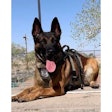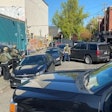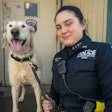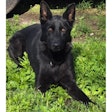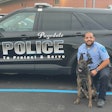One afternoon about five years ago, I was summoned from my desk at the detective division of a major Southern California suburban sheriff's department and asked to meet one of the staff drill instructors at our academy gymnasium.
When I walked into the gym, I could see that the DI was not having a good day. Two other instructors had a young white male cadet spread eagle on the wall, and I could see that he was having an even worse day.
The cadet was dressed in his workout clothes and, when I approached, one of the instructors ordered the young man to take off his T-shirt. His upper body was "sleeved" with numerous intricate tattoos and the instructors wanted my opinion of their meaning.
These were not the "store bought" flash tattoos of a youthful rebel or the military tattoos of a former soldier or sailor. From his waist to his shoulders, this clean-cut blond cadet was adorned with tattoos of complicated knots, runes, and other symbols associated with hardcore skinheads and the Aryan Brotherhood prison gang.
The young cadet's story was that he had once been a devotee of hardcore punk and skinhead music and that the tattoos had no other meaning. I looked carefully at the tattoos, which clearly took years to complete and cost hundreds of dollars. They were well done, sharply outlined in thin precise lines. But they weren't the work of a commercial tattoo artist. No, these were relatively recent homemade or prison-made markings produced by an experienced underground artist.
All of the tats were the same color, the blue-green that tattooing of black ink under light skin produces. They were not colorful like the type you might buy at the tattoo parlor.
Later, I was asked by the staff if the tattoos were gang tattoos and if they might be a problem if the cadet completed training and became a deputy sheriff. The tattoos were not gang specific and did not indicate membership in any gang I was familiar with. However, in my opinion, this young man should not have been allowed to complete the academy because you can bet your "risk management" budget that his body decoration would become a problem in the future.
Our cadet was obviously associating with someone who had the experience and time to painstakingly cover him with underground ink. And if he was so into hardcore punk and skinhead bands, he must have certainly known the meaning of the symbols he had so carefully chosen. Although the cadet had avoided overt Nazi symbols, his tattoos clearly identified him as sympathetic to hardcore skinhead and white supremacist groups. No one except the most extreme believer would cover his body with these symbols.
And even if the young man had disavowed himself of such beliefs, I advised the staff that his tattoos would be a liability on the job. Can you imagine what would happen if inmates in the County Jail or gang members in South Central Los Angeles recognized these tattoos on a deputy's arms? And if the tattoos were revealed in court in a trial in which the deputy was accused of brutality against a person of color, the department would have to pay a massive claim. He is, after all, permanently marked with symbols associated with hate groups.
Tell-Tale Tattoos American and even European street gangs have traditionally used tattoos to intimidate, show gang affiliation, and indicate rank. Gang tattoos are also the gang member's permanent record. They tell who he is, what he believes, what he's done, where he's been, where he did time and for how many years, and how many people he's killed.
If gang graffiti is the newspaper of the street, then gang tattoos are the "signposts to the soul." Sadly, many American law enforcement officers are illiterate in the language of gang tattoos. Such ignorance can be hazardous.
The permanent marking of the gang member's body, especially his face, is an outward sign of a lifelong commitment to the gang and an intimidating challenge to both would-be rivals and law officers.
The following is a basic primer on how to read gang tattoos. It's not intended to be comprehensive. But if you learn this material, then you will be able to understand many of the symbols that have been inked into the skin of some of the worst gang criminals.
Black Gangs
Black Guerrilla Family
California inmate and former Black Panther George Jackson started the "Family" in the 1960s. Later, this organization became a revolutionary Maoist organization known as the Black Guerrilla Family (BGF) on the West Coast and the Black Liberation Army on the East Coast.
Like many other prison gangs, BGF members are told to avoid obvious membership tattoos that can be used by law enforcement to validate membership and lock them down in the Security Housing Unit (SHU). But once it's obvious to staff that someone is a member of the BGF, the members will tattoo themselves and wear their BGF symbols openly.
The most obvious BGF tattoo is, of course, "BGF." You will also see the numbers "276," with 2 representing "B," 7 representing "G," and 6 representing "F."
Other common BGF symbols include a dragon coiled around a prison tower and a machete crossed with a shotgun or rifle. Since BGF started as a Maoist group, members often sport the red star of the Revolutionary Communist Party.
The Bloods
During the Watts Riots of 1965, I lived in Compton, Calif., where I ran a teen center as part of a War on Poverty program. During the rioting and looting in my Willowbrook neighborhood, I saw gang members from the Piru Street area dressed in red and calling each other "blood brother." I believe this was the early roots of the group that became the Piru Street gang and soon united with other anti-Crip gangs to form the Bloods.
Although there are only about 70 Blood gangs with about 7,000 members in Los Angeles County, they are more united and disciplined than their rival Crip gangs. However, one thing they have in common with their long-time enemy is that they have spread to most major cities in the United States and Canada.
All Blood gangs in Los Angeles were once allied. However, the rap music industry wars, revolving around Mob Piru member and rap music mogul Suge Knight, caused divisions within the gang. Now, several Blood sets have become enemies.
Blood tattoos are pretty basic. You will see P for "Piru" or B for "Blood." Another popular Blood symbol is CK. This can stand for "Crip Killer" or "Cop Killer."
The Crips
Sorry to disappoint anyone who actually believed the Stanley "Tookie" Williams propaganda, but he did not co-found the Crips in 1972. The Crips organized in the late 1960s in southwestern Los Angeles. Their name likely comes from the fact that the Crips' true founder, Raymond Washington, walked with a limp and used a cane. Crip is, believe it or not, shorthand for "cripple."
Today, this gang is anything but crippled. There are 210 Crip gangs with more than 17,500 members in Los Angeles County alone. And this Southern California gang is now national and even international, with affiliates in almost every major U.S. and Canadian city. There are even Crips sets in France.
Like the Bloods, the Crips are not very imaginative with their tattoos. Their most common symbols are the letter C for "Crip" or BK for "Blood Killer."
Blood killer is a strong indication of the historic enmity between the Crips and their rival Los Angeles gang the Bloods. But not all Crips get along either. In fact, most Crips sets are rivals until they arrive in prison.[PAGEBREAK]
The Kumi Nation, 415
Not all African-American gangs trace their origin to the streets of Los Angeles. This is true even in California, and it's especially true in Northern California where the Kumi Nation, also known as 415, is very active.
Organized in the Oakland area, Kumi Nation originally called itself "415" for what was then the local telephone area code. The group mutated and hardened in the California Youth Authority and the adult prison systems to become the Kumi Nation. Kumi Nation is also sometimes known as the African National Organization, and it actively recruits members into the Black Guerilla Family.
Kumi Nation, like the BGF, embraces African and revolutionary symbolism. Members often bear tattoos that show African warriors springing out of the African continent. The warrior usually holds an assault rifle in one hand and a flag that reads "415" in the other. Kumi Nation is a highly sophisticated criminal organization. It is aligned with the Bloods and very disciplined.
The Black Gangster Disciples
Perhaps the most active black gang to organize outside of California is the Black Gangster Disciples out of Chicago. Organized by King Larry Hoover in the 1970s, BGD-or as it's sometimes known "GD"-is part of the Folk nation and can be classified as a super-gang.
Many Los Angeles-based Crip gangs claim an alliance with the BGD. However, since this gang's influence has begun to grow in the Crip territories of South Central Los Angeles, many Crip sets have come to think of them as rivals.
BGD symbolism includes the six-pointed "Star of David" with "GD" or "BGD." Some sets are also marked with upended pitch forks.
Note: Behind bars, almost all black inmates fall under the control of the Black Guerilla Family. And in prison, the BGF is much more powerful than any African-American street gang. The BGF makes sure that these gangs obey BGF directives while they are in prison.
Click here to visit the Gangs Photo Gallery for examples of black gangs' tattoos.
Hispanic Gangs
Criminal gangs are nothing new in Southern California. The city of Los Angeles was founded in 1849, and some of its first residents were famous bandit Joaquin Murrieta and members of the Five Joaquin gang that terrorized ranchos and travelers throughout the area.
The migration of Hispanics from Texas and Mexico to California in the early 1900s brought the "Pachuco" culture from the border cities of El Paso and Juarez to the West Coast. The result was that Hispanic criminals in Los Angeles began to bear the "ept" tattoo of the El Paso Tip gang and the "Pachuco cross," which was originally a "t" for Texas. The "t" soon evolved into a religious symbol of a cross on the web of the hand.
Later, the Texas Prison Gang, "Syndicato Tejano" (Texas Syndicate), migrated into the California system. The now familiar address of "Ese" is the Spanish pronunciation for the letter "S," which was at the time a covert method for gang members of the "Texas Tip" to verbally acknowledge each other.
Eventually, the Texas syndicatos and the Los Angeles gangs began to grow apart. Los Angeles-area Pachucos distinguished themselves from the Texas and other "foreign-born" Pachucos by tattooing a crude "LA" or an "M" symbolizing the East Los Angeles Maravilla gang on the webs of their hands. These gangs also used the number "13" to covertly represent the "M," or 13th letter of the alphabet. This symbol is sometimes seen in Roman numerals "XIII" and as "213" as a play on the local area code. It should also be noted that the Los Angeles Dodgers' logo with the "L" forming the cross on the "A" was a tattoo that many old Los Angeles gang members wore long before the "Bums" arrived in Chavez Ravine.[PAGEBREAK]
The Mexican Mafia
The Mexican Mafia prison gang was organized in 1956 at the D.V.I. Youth Authority facility in Tracy, Calif. It was no accident that the members chose the letter "M" and its Spanish pronunciation "eme" to represent the gang since most members were from the Los Angeles area and were members of the Maravilla gangs.
Mexican Mafia symbolism can be complex. Common tattoos include the black hand (a nod to the Sicilian-American gang the Black Hand), "M," "13," "213," the Aztec shield and its symbol of eternal war, and the Mayan-Aztec numerical symbol of two horizontal parallel lines topped by three dots (13).
For a long time, Hispanic street gang members in Southern California have been marked with "South Sider" and "Sureño" (sur is "south" in Spanish) tattoos to show their strong support of the Mexican Mafia prison gang.
Currently, there are more than 530 traditional turf-oriented Hispanic street gangs in Los Angeles County with more than 53,000 members identified in the Cal-Gang system. All of these gangs are Sureño gangs. A small number of them are in rebellion against the Mexican Mafia.
I will mention the three largest and most widespread loyal Los Angeles Sureño gangs. They are super-gangs and can be found internationally. All three super-gangs are major traffickers in human beings, narcotics, and false identification.
- The Florence ("Florencia" in Spanish) gang was organized in the 1950s in South Central Los Angeles around Florence Boulevard. The gang members identify themselves with tattoos of the words "Florencia," "Florence," and "F13."
- The Eighteenth Street gang was formed from rejects of the Clanton 14th Street gang in the 1960s. Eighteenth Street took its name from the nearby 18th Street (Calle Diesiocho in Spanish). They use the tattoos "18," "XV3," "XVIII," "Diesiocho," and sometimes "666," which adds up to a total of 18.
- Mara Salvatrucha was formed by Salvadorian immigrants who were living in the 18th Street neighborhood. Some criminally minded Salvadorians joined Eighteenth Street or other local gangs but, by the mid 1980s, they had formed their own gang and became rivals to 18th Street. "Mara" means gang in El Salvador but, in Los Angeles, it also stood for the Maravilla coalition of Los Angeles gangs. The MS combined it with "Salva" for Salvadorian and "trucha," a calo (Pachuco language) gang slang for "look out." So Mara Salvatrucha means "look out for the Salvadorian gang." Mara Salvatrucha members are often heavily tattooed with symbols, including "MS," "MS-13," the Satanic inverted pentagram, and the devil horns hand sign. You will sometimes find all of these symbols tattooed on the face of a hardcore MS-13 members.
The Nuestra Familia
By the mid 1960s, the Nuestra Familia ("Our Family") prison gang had formed in opposition to the Mexican Mafia. It was strongly influenced by Southern California defectors from the Mafia and Maravilla gangs and those who felt victimized by the "Eme." However, the majority of the NF membership came from Hispanic street gangs operating in Northern California.
"NF" members sometimes refer to the gang as the "Ene" based on the Spanish pronunciation of the letter "N." Common NF tattoos include the number "14" or "XIV" for the fourteenth letter of the alphabet, which is N. You will also see more intricate images such as a sombrero with a bloody machete. The roots of this symbol are easy to trace. Many of the original NF members were from California's small farming communities and rural towns. They identified with the struggle of the migrant workers and campesinos who were organized by Cesar Chavez. The gang even adopted the stylized eagle used by the strikers, the "huelga" (strike) bird, which is often tattooed on Nuestra Familia and Norteño gang members.
Note: California officers should know that the city of Bakersfield is the Mason-Dixon line dividing the Norteños and Sureños, and these two groups remain at war. The primary cause of the violence is the fact that Sureño gangs in huge numbers are invading Norteño turf. It is also Sureño gangs such as MS-13 that are spreading across the nation.[PAGEBREAK]
White Gangs
The Aryan Brotherhood
The most prominent of all white prison gangs is the Aryan Brotherhood. Often called the "Brand," the Brotherhood is pervasive, powerful, and violent.
In California, the 62 currently identified validated members of the Brand are locked down in the infamous Pelican Bay State Prison SHU or they are facing a federal RICO trial in Los Angeles. Yet, they still control the white prison population. This is indicative of how much power and influence the leaders of the Aryan Brotherhood have over white prisoners. Regardless of whether white inmates were skinhead, punk, or outlaw motorcycle gang members on the outside, on the inside they owe their allegiance to the Brotherhood.
The Brotherhood has adopted some of the most complex symbology of all criminal gangs, incorporating Celtic and Norse myth along with the usual gang markings. Common Aryan Brotherhood tattoos include the letters "AB," "Brand," and the three-leafed clover or shamrock. AB can be written covertly as "1-2" for the first and second letters of the alphabet.
AB and the Brand are the simple Brotherhood symbols. Members of this gang also sport Celtic runes for AB, leprechauns, and "Sinn Fein" (a reference to the Irish Republican Army). If in addition to the shamrock and AB tattoo the subject also has a falcon or a hawk depicted, it may indicate that he is a in a leadership position.
Note: The Aryan Brotherhood is not associated with such neo-Nazi groups as Aryan Nation, the Aryan Warriors, or the Aryan Circle. However, they all espouse racial hatred.
Nazi Low Riders
Because the AB is locked down, they have appointed the Nazi Low Riders gang as a surrogate army to do the AB's bidding on the streets.
Many of the Nazi Low Riders are expert tattoo artists, so most of the membership has major ink. They use the letters "NLR" or the equivalent runes. They also often sport woodpecker tattoos (all white male inmates are "peckerwoods" in AB terminology) or tattoos that read "100% Wood," "88," and "44." The NLR tattoo 88 stands for "HH," meaning Heil Hitler. H is the eighth letter of the alphabet. The number 44 is the sum of 14, 12, and 18. The 14th letter of the alphabet is "N," the 12th letter is "L," and the 18th letter is "R." Hence 44 is a way of writing NLR.
NLR members can be extremely hazardous to law enforcement officers. Even though the Aryan Brotherhood has ordered NLR members to not make direct assaults on police because such actions can cause "too much public attention," it's understood by NLR members that if they are confronted by officers that they are to go down fighting.
The Art of Deception
Outsiders can only learn so much about a particular gang's tattoos and symbology. One reason for this is that gangs are constantly coming up with new ways to disguise the meaning of their tattoos.
Gangs have used ethnic dialects and alphabets of Nahuatl (Aztec), Swahili, Gaelic, and both Celtic and Germanic runes to hide the true meaning of their tattoos. I have also seen tattoos that feature numbers on dice, dominos, and playing cards. Morse code, American sign language, the common prison "Tic Tac Toe" codes, and a gang's own code (like the BGD code) are also common elements in some gang tattoos.
If you want to know your local gangs and their enemies and associations, make friends with your local custody cop or prison guard and talk to him about the tattoos that he sees. And next time you are booking a tattooed suspect, take a closer look at his ink. They may tell you more about the subject than his or her rap sheet.
Posers Beware
Gang tattoos cannot be bought and should not be worn lightly. Posing as a gang member and wearing gang tattoos that you haven't earned is a very bad idea.
I once testified in a multi-murder case involving a young Hispanic man who had been a member of a minor weight party crew. Years later, he decided to be a real gang member and he got himself jumped into a traditional Hispanic gang in El Monte. Then to look more like a gangster, he had himself tattooed with not only the gang name but numerous other prison tattoos indicating many years behind bars.
However, upon his conviction and arrival on death row, he learned the folly of wearing tattoos that he didn't earn. He even refused to go to the yard with his fellow Mexican Mafia members because the leaders had "greenlighted" him, authorizing any Mafia member to kill him for not earning his ink.
The Prison Tattoo Shop
Commercial tattoo shops have become extremely popular and accepted in mainstream America. The prison tattoo shop, however, is an underground operation. Tattooing in jails, juvenile halls, and prisons is a violation of the rules. So the techniques and tools are contraband. Even so, tattooing goes on all the time in prisons and in jails.
Inmates are innovative when it comes to setting up tattoo operations. The most basic prison tattoo system is a needle wrapped in thread that can be dipped into ink. Pigments are also formulated from ink pens, carbon paper, and dyes. Most prison tattoos are black because black ink produces the most contrast and clearest lines. It also tends to fade less.
Today, even in the most secure prisons, convicts use make-shift tattoo guns and electric needles. Inmates are quite ingenious at engineering tattooing equipment from electric toothbrushes and small appliances with motors.
The true prison tattoo artist is highly honored and well paid for his work. His tools, patterns, and inks are protected by the convict code. Some artists are even under contract to specific prison gangs and races.
Tattooing can transmit diseases like AIDS and hepatitis, and poor hygiene and unsterile needles also cause infection and abscesses. However, most prison tattoo artists are smart enough to keep their needles and tools clean and pristine. Their motivation for doing so is easily understood: Inmates make short work of sloppy artists.
Outlaw Biker Tattoos
Although they seem to impress some cops with their colorful tattoo styles, bikers get little respect in prison. Short of the "full patch" of an outlaw motorcycle gang tattoo, most biker tattoos are generic to bikers and can be worn by most any of them.
Typical biker tattoos such as Harley-Davidson wings, 1%, "FTW," etc., can be bought in tattoo stores and are often in technicolor. Many outlaw motorcycle gangs even run professional commercial tattoo shops, so their members have spectacular, intimidating tattoos in full, living color.
The tattoos on a big, bruising biker should not automatically make you think that the guy is bad. The really bad guy is a skinny, pale man with NLR for "Nazi Low Rider" tattooed on his body in black or monochrome ink. Remember, anybody can buy biker tats, even your grandmother. In contrast, the NLR letters must each be earned in prison. And they are earned by violent acts.
That said, there are some biker markings, particularly those of outlaw biker gangs, that are significant. If you see a guy who has Hells Angels tattoos, then he is likely a Hells Angel. The gang has copyrighted its symbols. So any commercial artist who starts using them will get shut down. And, of course, the Angels have their own way of responding to people who are not in the gang who wear Angel tattoos.
The biker world is a drug world, so many common biker tattoos point to the drug culture. You will see marijuana leaves, the number 13, pipes, poppy flowers, and hypodermic syringes. One of the most frequently seen biker tattoos is "DFFL," which stands for "Dope Forever, Forever Loaded." It has evolved into specific gang tattoos of "AFFA," "Angels Forever, Forever Angels" for the Hell's Angels, or the counter, "MFFM," "Mongols Forever, Forever Mongols" for the rival Mongols motorcycle gang.












